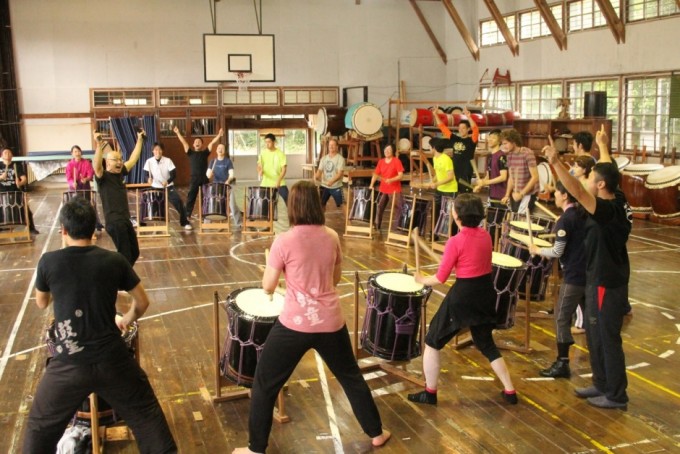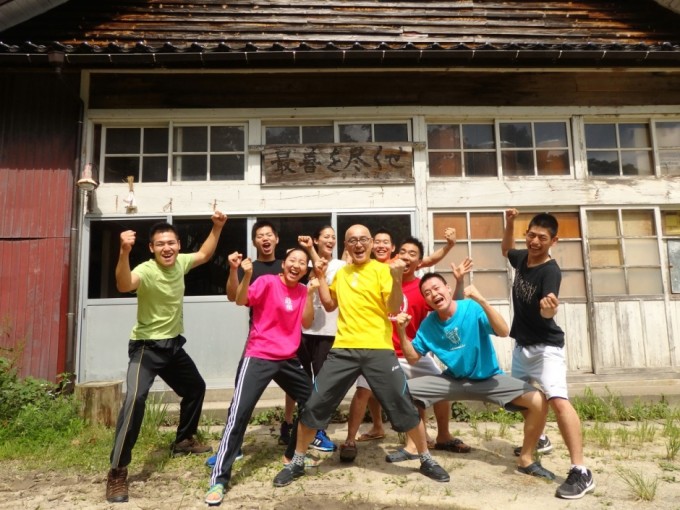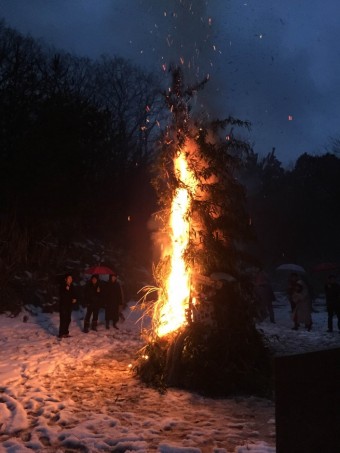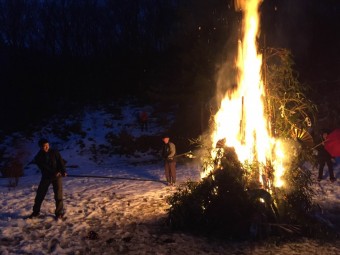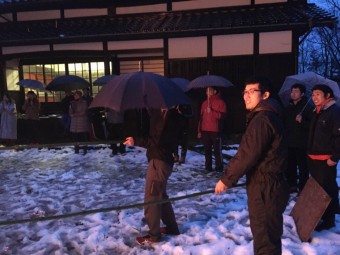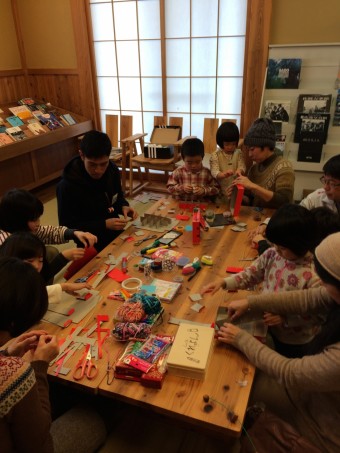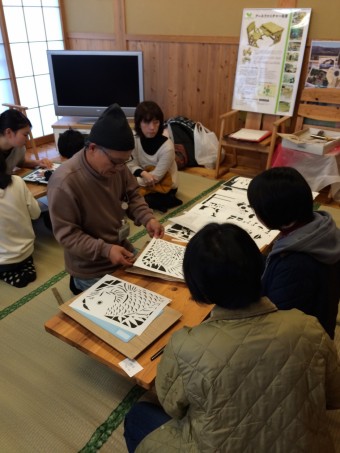Posts by Kodo Cultural Foundation
“Request for Donations to Help Repair Spuddy” by Yasuko Homma
Spuddy Needs Your Help
Today, I’d like to let you know about a special member of the Kodo family who needs your help.
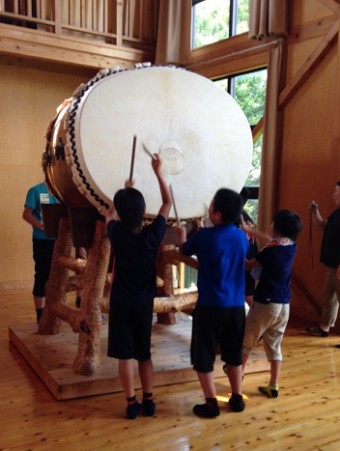
Yamaimo-kun, nicknamed Spuddy in English due to his resemblance to a certain root vegetable, is one of the large taiko that lives at Sado Island Taiko Centre. He is one of two massive taiko at the Centre that were handmade by Kodo members. Yamaimo-kun and his friend Butabana-chan, a.k.a Miss Piggy, have been working hard at our centre since 2007 when it opened and they were completed. They welcome everyone who wants to have a hit and have become the mascots of our interactive facility.
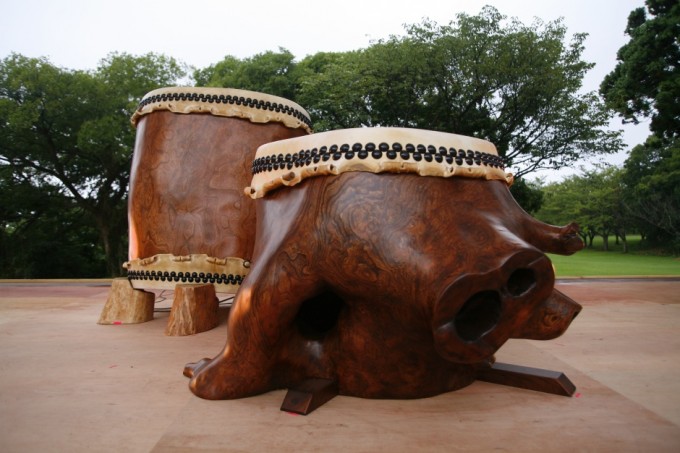
After taking a beating almost every day for a decade, poor Spuddy now has holes in both of his heads. Shinchan-sensei has patched him up with small pieces of hide, but the bandages are only a temporary fix.
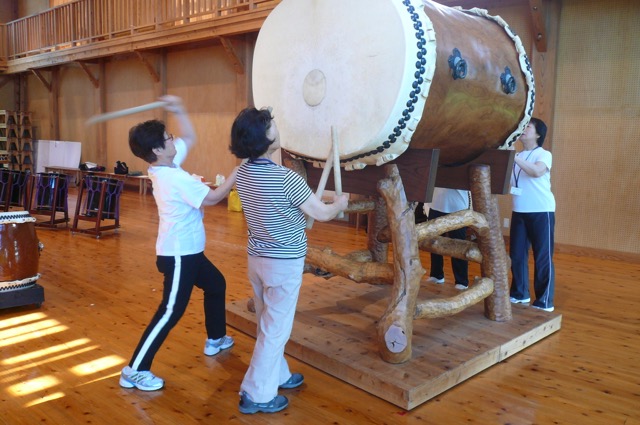
Since the beginning of the year, we have had a donation box at the Centre so that visitors can help us buy new heads for Spuddy. In eleven months, we have raised around 70,000 yen for his “treatment.”
Spuddy is a big boy and his heads are about 1.4m in diameter, so it will cost around 100,000 yen to fix him. We have decided to schedule this procedure during January when there are less visitors due to the cold winter season.
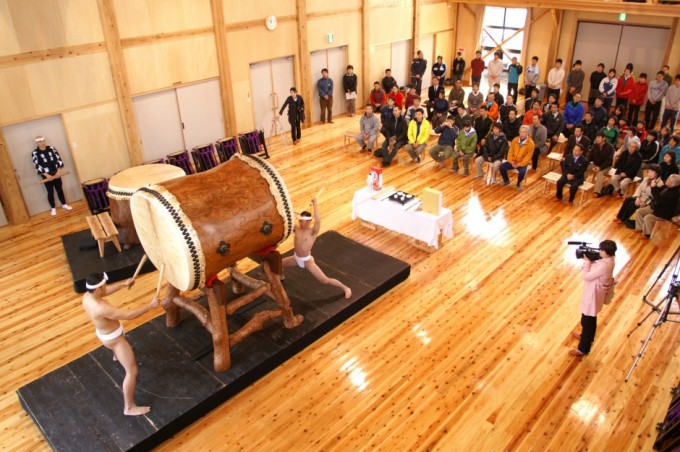
Now that winter is upon us, we have decided to try to raise the remaining funds required by asking for donations online.
If you would like to help us mend Spuddy, please contact the Kodo Cultural Foundation for further details. http://www.kodo.or.jp/foundation/index_en.html
Thank you in advance for your kindness!
“Last Chance to Apply for ‘Kodo Juku 2016’!” by Michiko Chida
Last Chance to Apply for “Kodo Juku 2016”
This year we will hold Eiichi Saito’s annual live-in taiko workshop “Kodo Juku” from Oct. 7 (Fri) through 10 (Mon/Public Hol.) at the Kodo Apprentice Centre on Sado Island. Eiichi Saito took over the reigns to facilitate Kodo Juku in 1992 and back then we held Kodo Juku 4 times a year. For some time now, we have held it just once a year but one thing that has barely changed is the content. Each year the participants tell us how the simple taiko drum led them to find new connections between their own body and soul and helped them to create wonderful new bonds with people they had only just met at the workshop.
Everyone is welcome at Kodo Juku, whether you’ve played taiko before or not. First-timers will discover the special power of taiko and experienced players will discover many hints to playing taiko that truly moves people. The only condition is that you’ve never been to Eiichi Saito’s Kodo Juku before, as it is a once-in-a-lifetime workshop with no repeaters or groups of 2 or more.
The application deadline is July 30, so don’t delay! We look forward to receiving your application soon and welcoming you to Sado Island for Kodo Juku this autumn.
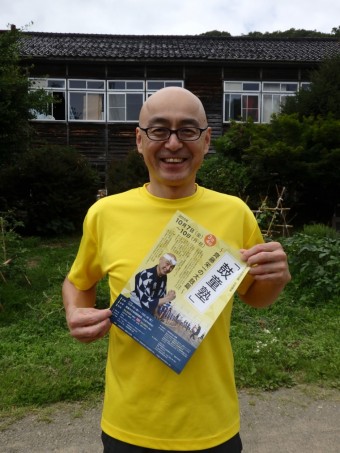
Eiichi Saito says “Join me for Kodo Juku on Sado Island!”
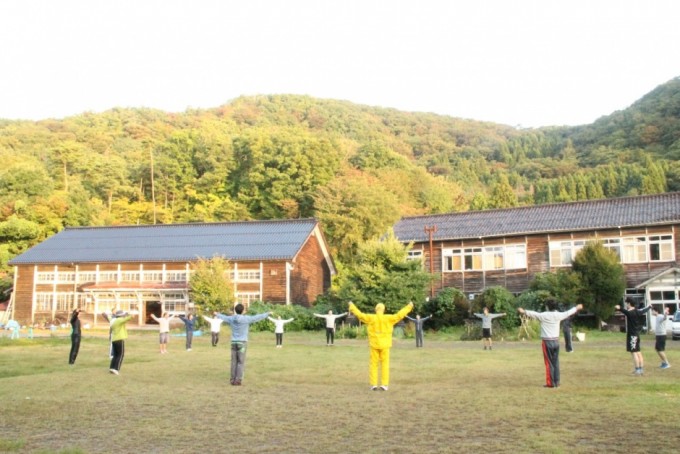
Early morning stretch time at Kodo Juku 2015
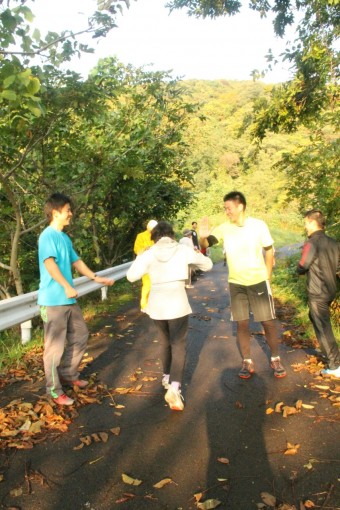
Jogging in the morning with the apprentices
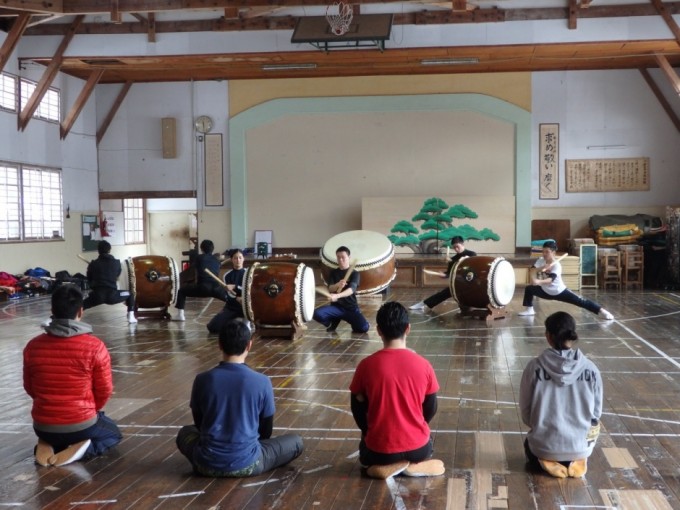
Workshops are held in the Kodo Apprentice Centre gym, where the apprentices spend two years training in hopes of one day performing on stage with Kodo.
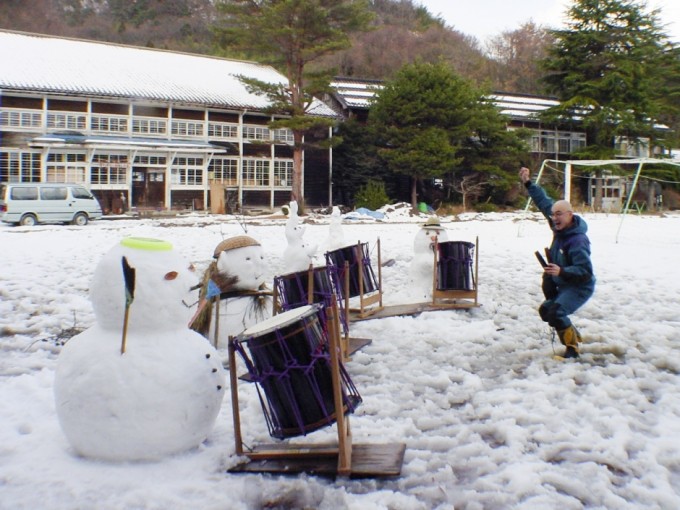
Preparations for each Kodo Juku begin 8 months prior with a lot of enthusiasm!
The second year apprentices act as staff during Kodo Juku each year, learning valuable skills as they host the participants. Eiichi and the apprentices can’t wait to welcome everyone to Kodo Juku this fall!
Kodo Juku: Eiichi Saito’s Taiko Workshop
Oct. 7 (Fri)–10 (Mon/Public Hol.), 2016 Kodo Apprentice Centre, Kakinoura, Sado Island, Niigata
Details for Kodo Juku 2016
http://www.kodo.or.jp/ws/juku_eiichi_en.html
Community Development Course Trainee Report: “Dondoyaki at Kodo Village”
Jan. 15 Dondoyaki (New Year Bonfire) at Kodo Village
There was a Dondoyaki* event at Kodo Village on January 15.
Before dark it was raining, but when Kenta Nakagome cheerfully shouted out “Seh-no!,” the rain stopped and we all started singing a Dondo-yaki song as the bonfire was set alight.
I had never heard this song before.
Dondoyaki is a traditional Japanese event. The Kodo members burn their broken bachi (drumsticks), worn-out fans and bamboo dance props… so the essence of performing arts infuses the flames, taking that lifeforce up into the night sky in the smoke.
After the event, we, the Community Development Course trainees, were on duty watching the fire go out. As I watched the ashes in the dark, and weakened, gentle flames, I could hear many sounds as it crackled and burned.
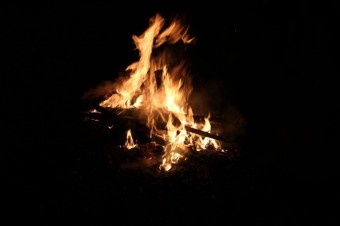
By Misaki Nakamura, 2014-2015 Community Development Course trainee
*Translator’s Note: Dondoyaki Explanation from Kodo eNews Issue 3
Every year on January 15th, Kodo Village holds its own Dondoyaki, a traditional Japanese fire ceremony to farewell the New Year gods back to the heavens. New Year decorations and good luck charms and amulets from the past year are burned in the fire, a tepee-like structure made of bamboo, thatching hay, and straw. At Kodo, players burn the drumsticks they can no longer use in this fire. It is said that the deity of the New Year goes back home with the smoke of Dondoyaki,, so we like to send the heart and soul forged in the drumsticks along with it. Mochi (pounded rice cakes) from the week before is also toasted over the fire and eaten to bring good health in the year ahead.
“’Tatakokan Matsuri’ – Oh What Fun!” by Masami Miyazaki
Sado Island Taiko Centre Festival “Tatakokan Matsuri” – Oh What Fun!
We held a festival called “Tatakokan Matsuri” at the Sado Island Taiko Centre on Dec. 14. We’d had blizzards leading up to that weekend, so we were wondering if we could finish clearing the snow away from the parking lots and if people could reach our Centre safely…. but in spite of all our worries, so many people came along on the day!
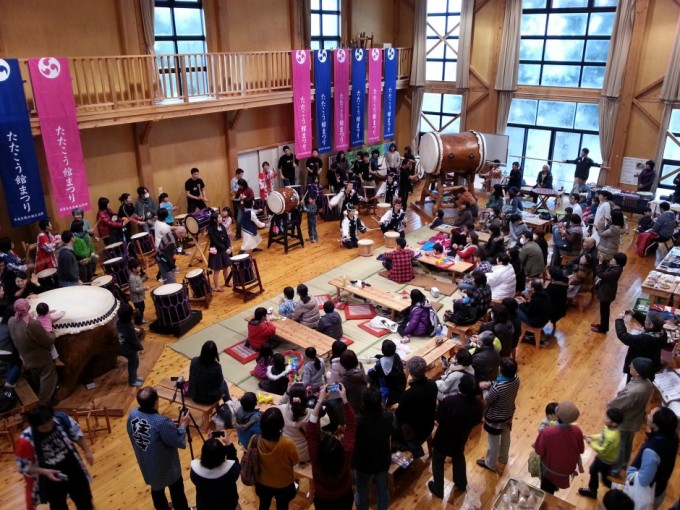
The festival ended on a lively, high note with Ogi Matsuri Daiko performed by Sado Taiko Club (mainly Kodo Cultural Foundation staff members), taiko group Anedaru, and many of the festival attendees.
150 people gathered for the festival, including the stall holders and performers. They made the Centre so lively and warm.
[Workshop 1] Advent Calendar Workshop: Children and parents worked together happily making calendars. They were all looking forward to opening each box every day until Christmas!
[Workshop 2] Sagegami (New Year’s Decoration) Workshop: An instructor from Shukunegi area shows participants how to make Sagegami. Let’s see how well can they cut the paper out from the pattern…
Thank you very much to all of the performers, stall owners, staff, Kodo apprentices, and especially to all the festival-goers, who braved the snow to join us! Tatakokan Matsuri really brings people together, and we look forward to hosting another one someday soon!
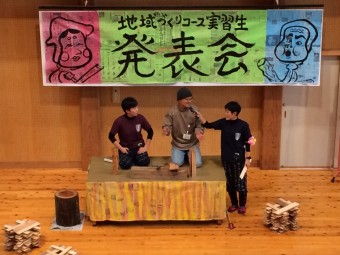
Presentation by the Kodo Cultural Foundation Community Development Course trainees: They have lived on Sado since April 2014. They gave a presentation on what they have learned from the locals on Sado Island. In this picture, they introduce “Koba-ya,” a workshop where wooden shingles are made in the Shukunegi area.
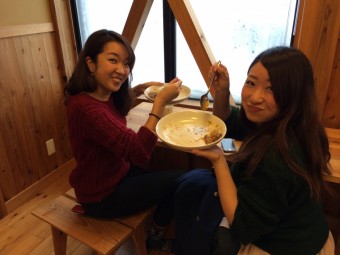
Some Kodo staff members also popped in. You can tell how the curry tasted by looking at their smiles.
▶Sado Island Taiko Centre (Tatakokan) Website (in Japanese)
▶Sado Island Taiko Centre (Tatakokan) Official Facebook (in Japanese)
“Kodo & Sado Featured on JNTO Website” by Kodo Cultural Foundation
On March 14, 2015, the new Hokuriku Shinkansen (bullet train) will open for travel between Kanazawa, Toyama and Nagano.
To promote this new route to Niigata and Sado to foreign tourists, a PR article in English about Sado Island is now featured on the Japan National Tourism Organization (JNTO) website.
http://www.japantravelinfo.com/blog/japanese-time-travel-in-sado/
The writer introduces Kodo, saying “If you have the opportunity to attend one of these (Kodo) performances in your area, I highly recommend it to experience the timeless quality of the island’s continuing creative spirit.”




